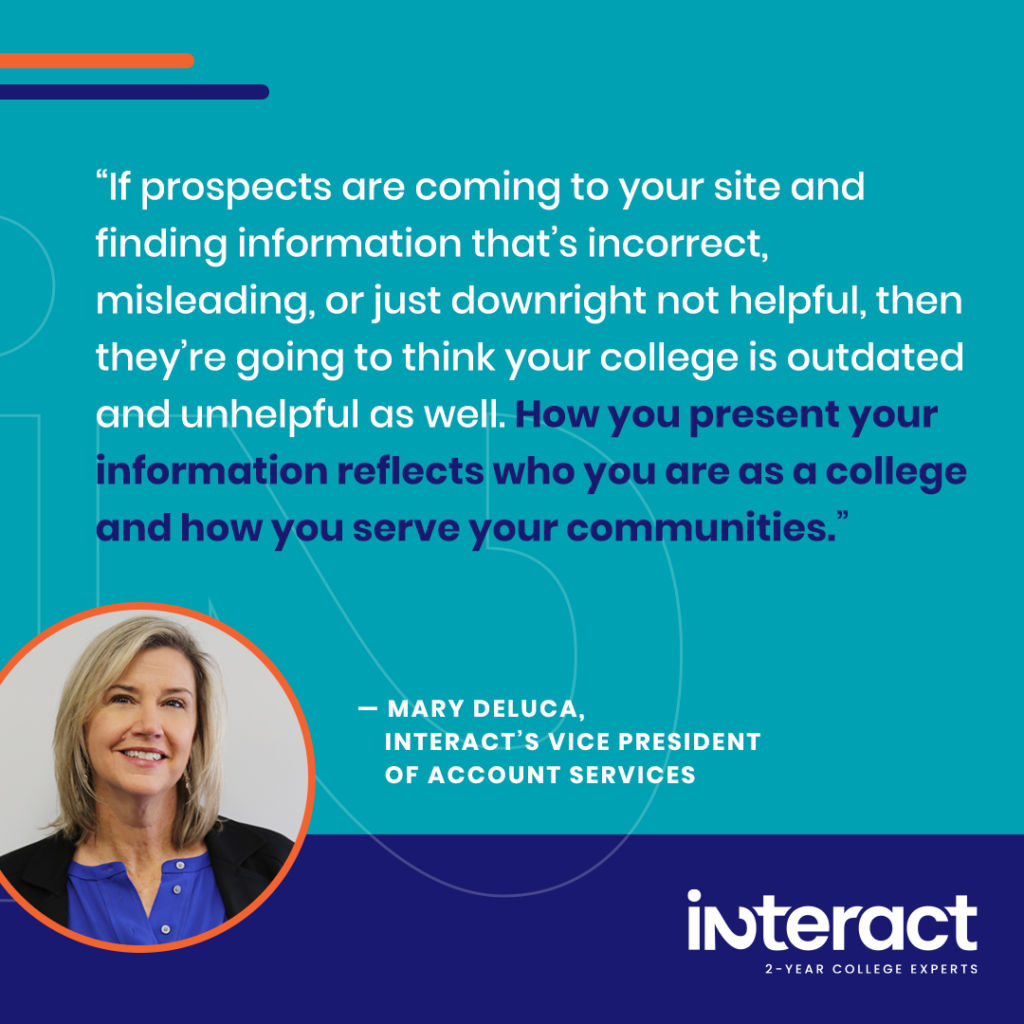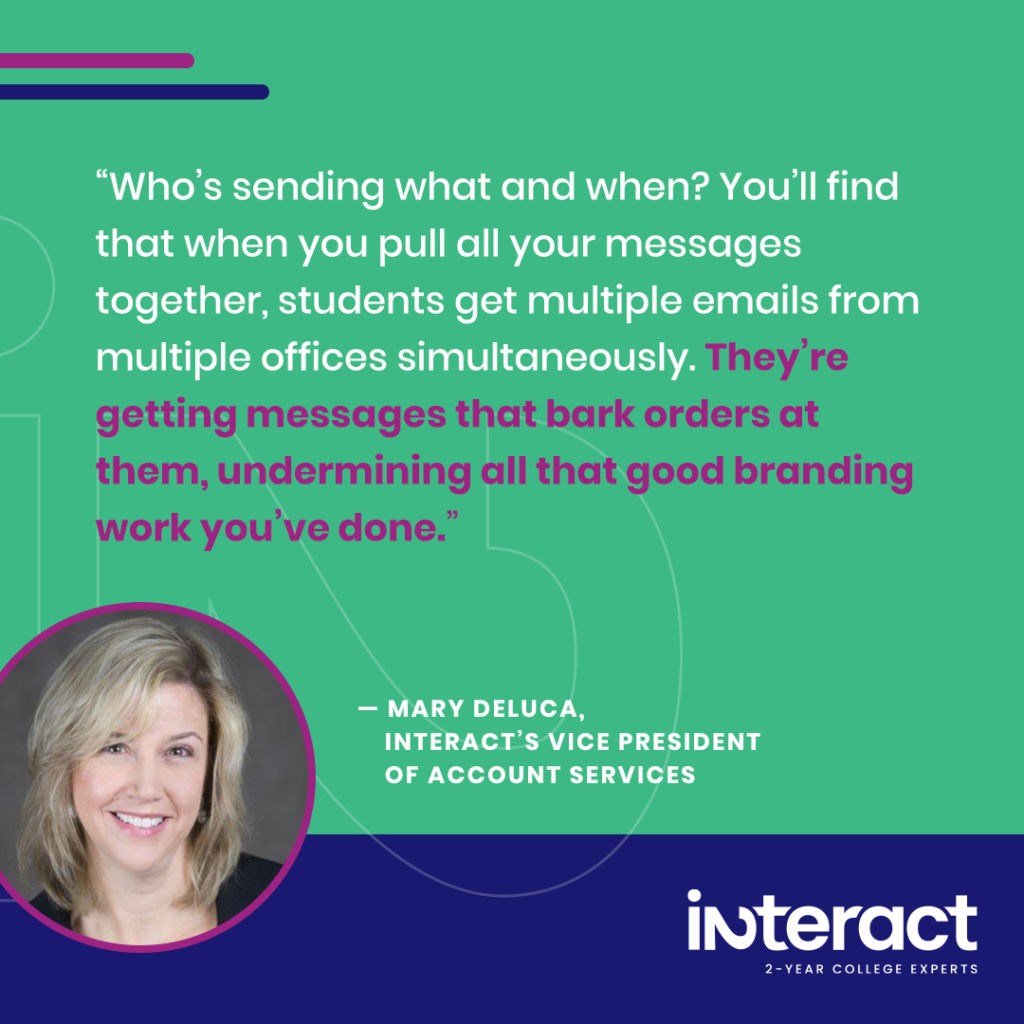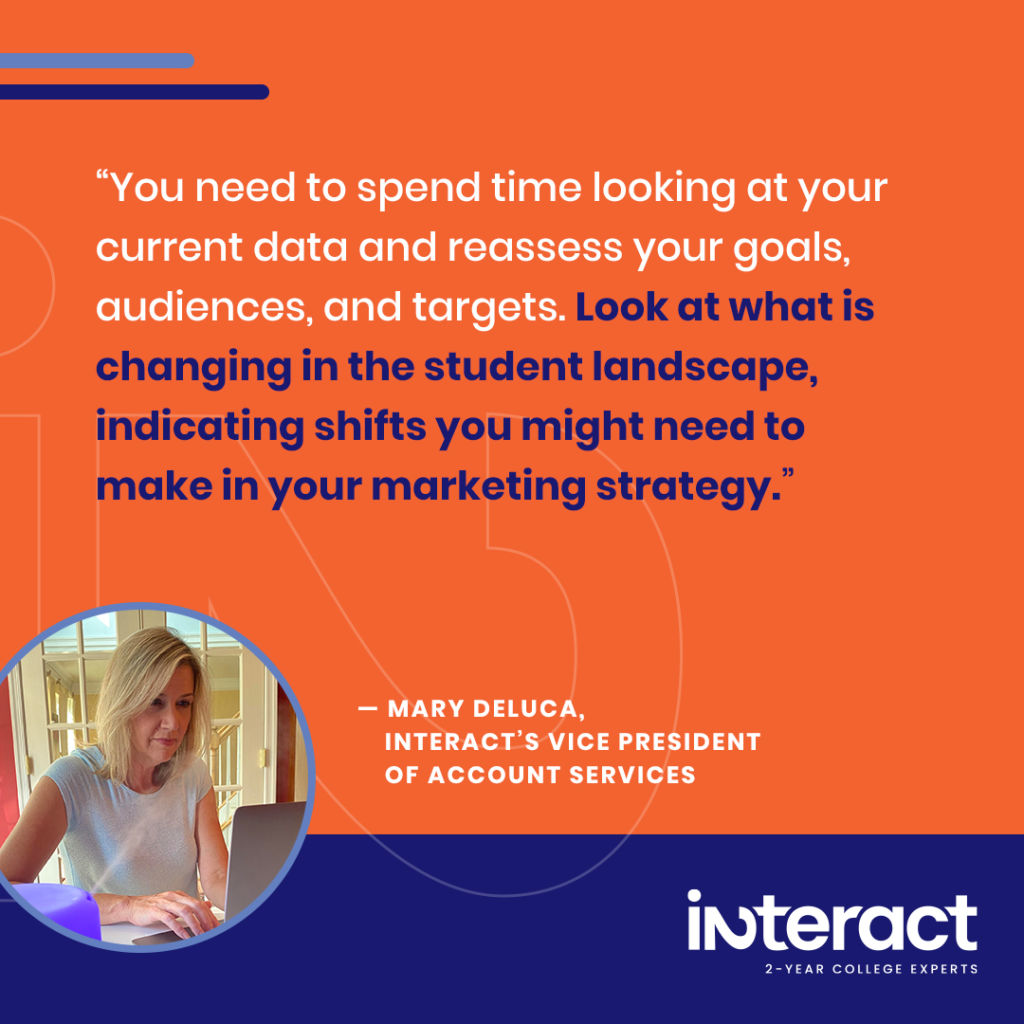
Does your marketing strategy need a makeover for 2023? Try taking an annual digital marketing inventory to measure marketing effectiveness. It’s a tremendous opportunity to capitalize on your wins and learn from your losses.
“When you’re under pressure and understaffed, you can feel like there’s no time for proper planning and assessment,” says Mary DeLuca, Interact’s vice president of account services. “But measuring your marketing effectiveness is what’s needed most so that you don’t waste time and money.
“It’s the only way to ensure you’re going to have the most impact.”
Why Should You Do a Digital Marketing Inventory?
Community colleges can’t afford a haphazard approach to outreach. A robust marketing strategy requires careful consideration, planning, and evaluation to really boost enrollment in the semester ahead.
Conducting a thorough digital marketing inventory can help you craft a plan to reach students when, where, and how they prefer. Remember, your digital marketing tools should be helping you build brand awareness, draw prospects, develop relationships, and ultimately boost enrollment and retention. But your tools can only perform well if configured properly. Otherwise, you may miss opportunities.

“You’re on that treadmill, and you’re just running, running, running and don’t feel like you can hit the pause button to assess,” says DeLuca. “But if you don’t, you’ll never get off that treadmill. Stopping to assess your marketing strategy is the only way to find out what’s worth spending your time and money on.”
Even if you have outstanding content, you won’t have a fully fleshed-out marketing strategy until you measure your effectiveness. It’s critical to ensure you’re hitting your key performance indicators (KPIs) to see how each marketing effort is measuring up. Taking a regular time out for an inventory means you can plan, reflect, renew, and return to the spring semester even stronger.
Make Your Digital Marketing Inventory an Annual Event
As the year winds down, block off a few days on your calendar to take a much-needed review. Swear off social media, put an away message on your email, and put your nose to the grindstone. It’s time to get a bird’s-eye perspective on your funnel and pinpoint where you might be missing conversion opportunities.
“We would set aside a day and reserve a room somewhere outside of the office so that we wouldn’t be distracted,” recalls DeLuca about doing regular marketing inventories at her former institution. “We’d order pizza, put on some music, and make an event out of it!”
DeLuca’s department would gather all communications materials from every office, spread them out on the table, and make sure their marketing strategy was up to snuff. Getting the whole team together for the inventory gave the added benefit of having multiple pairs of eyes scrutinizing the material. Plus, as DeLuca says, “It’s more enjoyable when you make a team event out of it.”
The better you understand your existing resources and materials, the easier it will be to make smart choices and plan changes in your outreach and retention efforts.
Step One of Your Digital Marketing Inventory: Online Info Health Check

The first step is to list all your digital platforms, including websites, social media profiles, and email marketing channels.
Now, scan your content and list all the information that needs updating …
Double-Check the Following for Your Info Health Online:
- Is your contact information up to date on your main web pages and social profiles? Try emailing and calling the info you have listed. You might be surprised when you find contact information that’s no longer current!
- Check the links in your social media descriptions and the main pages on your websites. Do you have any links that are broken or lead to incorrect pages?
- Do your branding colors and logos reflect the most current iterations across your platforms?
- Check every date on your pages and ensure they are for the correct year.
- Take a look at your email footer and other template areas that stay the same from campaign to campaign to ensure the information is current.
- Do you have any websites, web pages, or social media accounts that are no longer relevant that would be best to delete and redirect?

“If prospects are coming to your site and finding information that’s incorrect, misleading, or just downright not helpful, then they’re going to think your college is outdated and unhelpful as well,” warns DeLuca. “How you present your information reflects who you are as a college and how you serve your communities.”
Making sure everything is up to date is essential for having clear communication. Once you start looking, you might be shocked at how long it’s been since you updated your info.
Remember, your students are not Nancy Drew. If you have incorrect contact information or broken links to essential pages, they won’t wait to solve the mystery. They’ll contact your competitors instead.
Is Your Program Information Up to Date?
“Program information that’s not regularly checked, maintained, and updated can be really misleading and discouraging to students,” says DeLuca.
Whether information isn’t accurate …
Or new programs aren’t listed …
Then, at best, it’s a missed opportunity, and at worst, it turns students away.
Don’t let your information get stale on your program landing pages.
Instead, download DeLuca’s handy checklist to help you keep your information up to date:
Step Two: Measuring Marketing Effectiveness
It’s time to measure last year’s wins and losses in your digital marketing inventory.
Clean Up Your Social Media Accounts for Stronger Marketing Strategy

First, make a complete list of all your social media accounts — including the ones that might no longer be in use. Do you have the up-to-date login credentials for each one? Remember, abandoned social media sites can be hacked or filled with spam while you’re not looking. So, remember all of your long-lost profiles and clean them up or delete them.
What about those pesky unofficial pages on social media and Google Business Profiles? According to the digital marketing agency Corporate Three Design, those need to be addressed ASAP:
“Bad data is a primary source of confusion for customers throughout the discovery stage, particularly when searching for local businesses.
“Claiming, merging, and removing unofficial duplicate pages on Facebook is a way to combat this confusion on social media and improve your location’s overall NAP consistency (name, address, phone number, and website).”
How to Claim, Merge, and Remove Unofficial Pages on Facebook: The Official Guide to Unofficial Pages on Facebook
Here are some additional resources to help you clean up duplicate pages and impersonation accounts:
- Request ownership of a Google Business Profile
- Impersonation Accounts – Instagram Help Center
- Report impersonation accounts – Twitter Help Center
- Claim, delete, or share a LinkedIn Listing Page
Looking at Social Media Wins and Losses for Your New Marketing Strategy
Next, go to your social media insights and consider your top content to measure marketing effectiveness:
- Which posts performed well?
- Measure your impressions, engagements, and link clicks, and see if you can spot a trend.
- What did students engage with the most? Was it trivia Tuesday questions, mascot reels, student profiles, or something else?
Make a list of all your top content and write down what they have in common so you can repeat your successes in the future.
Next, look at your posts with the least amount of engagement and repeat the process — and this time, plan to drop this kind of content from your platforms and replace it with your more engaging post types.
Weighing Website Wins and Losses

Review your Google Analytics and crunch the data from the last year for your digital marketing inventory:
- What pages or posts had the most traffic?
- What page created the most leads?
- What info had the best dwell time, showing where students read most?
Then, look at your least-visited pages, pages with the worst dwell time, and those with the least traffic. Do you notice a trend? Can you detect any navigational challenges students might have had on these pages?
“Periodically, you need to check how people navigate your site and where they are stumbling,” says DeLuca. “You might have gone through a website redesign. But things get added and changed, and what you started with gets convoluted.”
Bringing in focus groups and having students test your site can be eye-opening. Give your beta testers tasks to accomplish on your website, see if they run into any challenges, and get their feedback to make your user experience better.
Efficient Email Marketing Strategies
It’s always a best practice for your marketing strategy to clean up your email lists at least once a year. Pinpoint those non-performing addresses and purge them, ensuring you only reach interested audiences. Your email list can show opportunities to strengthen relationships with prospects. But first, you need to filter the real prospects from the disinterested ones.
Then, it’s time to look at the communications you’ve sent over the past year:
- Where did you earn the best click-through rates?
- What messages garnered clicks, and which got you crickets?
- What calls to action were rallying cries, and which were just too quiet?
Then, reset your plan for the new semester accordingly.
Take a Holistic View of Your Emails for a Big-Picture Marketing Review
Remember, don’t just look at emails from your marketing department! For a comprehensive review, you’ll need to see the whole picture.
“It’s really important to gather emails from offices that marketing is not controlling,” says DeLuca. If your marketing department manages every email through the CRM and has a robust communication plan, that’s one thing. But that’s not the process for most colleges. Instead of warm, welcoming messages, you might discover some with cold, transactional, and confusing administrivia.
Financial aid, testing, student orientations, and payment deadlines — those messages usually contain the most common communications pitfalls.

“Who’s sending what and when?” asks DeLuca. “You’ll find that when you pull all your messages together, students get multiple emails from multiple offices simultaneously. They’re getting messages that bark orders at them, undermining all that good branding work you’ve done.”
What is the solution to this challenge? The most important step is to create a good email communication guide. That way, you can lead students through all the onboarding steps with well-timed, coordinated messages.
Setting New Goals for a New Marketing Strategy in 2023

Now that you’ve taken an inventory of your wins and losses and measured marketing effectiveness, it’s time to set new goals. Don’t be afraid to set your sights higher … and to jettison strategies and content that failed to produce results.
Research Is Key to Building a Solid Marketing Strategy
What’s the best way to produce a new, rock-solid marketing strategy? According to our VP, it all starts with research. Says DeLuca, “You need to take a deep dive into your enrollment data.”
Consider the following:
- Which audiences are you losing?
- Where should you build engagement with particular demographics?
- And how can you refine your toolkit to reach those groups more effectively?

“You need to spend time looking at your current data and reassess your goals, audiences, and targets,” says DeLuca. “Look at what is changing in the student landscape, indicating shifts you might need to make in your marketing strategy.”
Addressing the Whole Funnel in Your Marketing Plan
You might want to categorize your wins and losses according to the stages of your marketing funnel. See if you have adequate material for your awareness, consideration, and conversion phases. If you have any gaps, you can address them in your new marketing plan.
Remember, it’s not enough just to attract potential students at the top of your funnel. Are you still engaging students in the consideration and conversion phases? The further into your funnel they get, the more likely you’ll turn a prospect into a student.
Measuring Marketing Effectiveness for Stronger Enrollment in 2023
Taking the time to measure your metrics and take stock of your marketing effectiveness means you’ll be able to put your time, money, and efforts into better ROI for next year. You’ll have 20/20 vision on which strategies to adopt for the future and which to ditch to boost enrollment and retention.
And then, it’s time to wash, rinse, and repeat. Take stock of your efforts quarterly, if you can, or at least annually, and keep your marketing strategy strong 365 days a year.

“Give yourself the time to take a deep breath and cleansing look at what you’ve done this year,” says DeLuca. “You’ll have a healthy reset on your marketing focus and be inspired to be more strategic and creative.”
What if you don’t have the time or resources to do a robust marketing inventory? That’s where Interact can help, with everything from a communications audit to helping you build a rigorous marketing plan.
And for a DIY program landing page that’s up to date and engaging for your students, don’t forget to download DeLuca’s free, handy checklist here:





